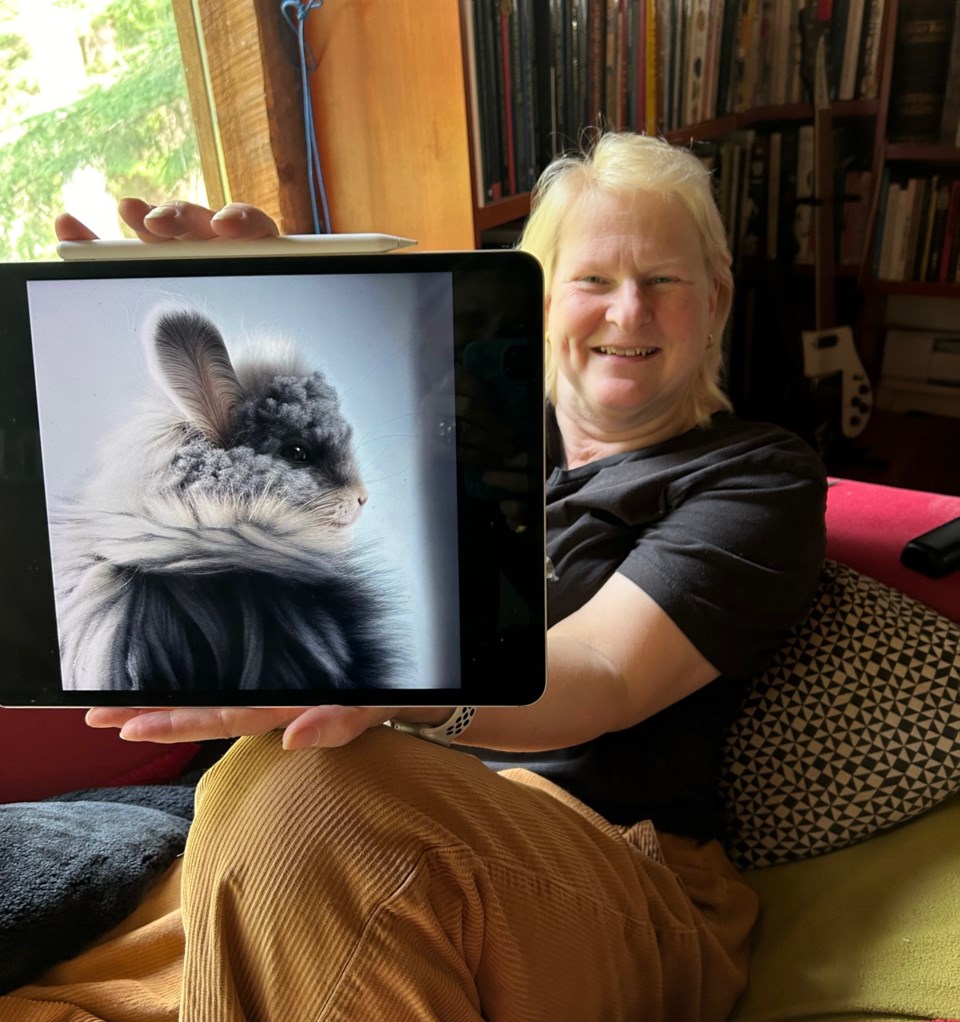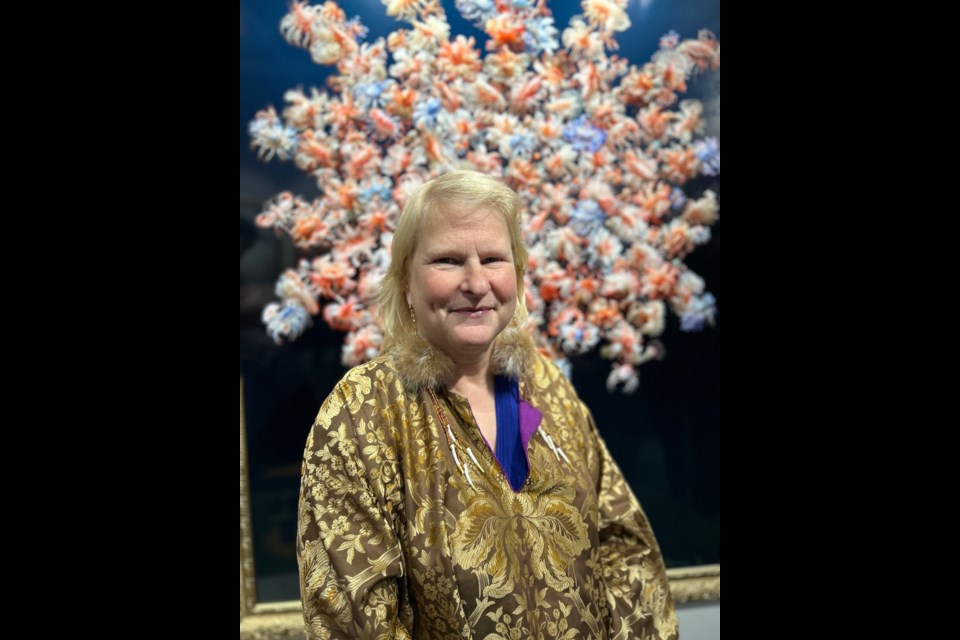Marian Bantjes laughs with delight — and a genuine sense of admiration bordering on awe — when she calls up an image that AI generated at her behest.
The fantastical creature on her iPad screen owes some of its DNA to a fluffy grey rabbit but no living animal would stare out at you with such magisterial splendour and wit. It amazes her that, with just a few keyboard prompts, her text-to-image app came up with a portrait of such perfect composition and colour palette.
“Doesn’t that creature look like he’s thinking,” she asks. “He’s got soul. I call him The Spy.”
She also thinks the image is deserving of being called art. As an image on her screen, she’d never call it her art, even though she can claim ownership. After all, AI (artificial intelligence) made it for her because she asked it to. But, if one day she paints The Spy, as she hopes to do, then she will sign her name to it.
Bantjes’ relationship with AI is… complicated. You can’t say that AI was her muse when she created Complications, a fascinating exhibit on display at The Hearth until April 22. Nor can you call AI her artistic partner. The exhibit’s whimsical prints represent hundreds of hours manipulating and composing images she generated with a computer program called Midjourney. And before she spent many more hours piecing them all together, she drew out the design by hand.
It’s her brain, her sense of humour, her absolute mastery of graphic design, that compel the viewer to be beguiled by each piece’s countless details which only become apparent when you step towards the massive gilt frame.
The vase that’s filled with a bouquet of fluffy white clouds? Come closer and you’ll see dozens of beefy, half-naked wrestlers locked in battle. It’s simply impossible not to giggle at the incongruity of it all. The branches of flowers arranged in stark contrast to the black background? You’ll wonder if she unearthed portraits by a Dutch master who hundreds of years ago was commissioned to paint endless variations of women’s intricate bouffant hair styles and neck collars, no two of them the same.
Banjtes used Midjourney’s text-to-image algorithms to create the individual images in each of the pieces.
“With Cloud Wrestlers, I didn’t decide ‘I’m going to make something with clouds and wrestlers.’ I discovered at some point that AI is very good at making clouds and then it started making these weird clouds. I just started collecting them. And then, at some point, I thought, ‘Well, what about wrestlers?’ I just said ‘Make two men wrestling’ or something like that and it put some of them in diapers and some of them in weird fencing garb and some of them have an extra limb or a missing limb.
“Then, when It comes time to make one of my big things, I think ‘What should I combine together?’ Originally the clouds were going to go with all these Jesuses [that AI generated.] But then I thought, ‘That lacks something. Let’s throw the Jesuses away. What about wrestlers and clouds? Oh, that’s hilarious.’ And that’s how that came about.”
The use of vases originated from a discussion with Douglas Coupland. She’d shown him some of the things she was working on — back when Complications was just a glint in her eye — and he said she should go bigger. He also suggested the use of figure ground.
“With figure ground, there’s a focus on an object and then there’s a background. When he said figure ground, the first thing that popped into my head was the image of the vase. I liked it because I thought most artists end up doing a vase of flowers. But the vase could hold anything. And what if there’s no focus of the vase; what if the vase is just a flat thing and stuff comes out of the void?”
Coupland was also at her 60th birthday party at her home on Bowen Island, where she’s lived for almost 30 years. She printed out some of the images that Midjourney had created for her and asked her guests if they were art. Some people said no. Bantjes said yes.
“AI is capable of making images of such astonishing beauty and surprise that it is very hard for me to say ‘That’s not art,’” she explains. “AI completely delights me at times, frustrates me at other times and continually astonishes me as to how stupid it is. It’s got this façade of intelligence that masks its supreme stupidity.”

It’s the stupid side of AI that makes her not fear it as an artist.
“AI has such an effed-up non-understanding of the world that it makes amazing things,” Bantjes says. All it has is access to trillions of pixels that it’s poached from the internet. An image that’s called “cat” isn’t tagged “five toes on each of four paws” so AI gives its cats six toes and three ears.
“[AI is] a system trained to recognize objects, styles, techniques, and even ‘concepts’ to a very limited degree, but it doesn’t understand those things, or how they relate to each other in the real world,” she writes on her Substack blog. “It’s a little bit smarter than a dog. You can easily train a dog to recognize the word ‘ball’ and be able to apply that word to many kinds of ‘balls.’
“With effort you could train a dog to recognize the difference between the striped ball and the red ball in your house, but it would be unlikely to recognize the difference between all striped balls and plain balls; furthermore a dog will never understand that ‘stripes’ are something that can appear on a shirt, or a wall, or that there is any relationship whatsoever between a striped shirt and a striped ball.
“AI is similar to that, but with a much, much larger ‘understood’ data set.”
Bantjes, who’s a member of the illustrious Alliance Graphique Internationale, has pieces in the Cooper Hewitt permanent design collection at the Smithsonian as well as the LA County Museum of Art. She says that instead of trying to control what AI produced by giving it more and more detailed prompts, she became interested in “giving it enough rope to hang itself.”
“I realized that instead of fighting against it, why don't I try to let it do what it wants to do? Just let it generate fantasy kitsch. And I love kitsch. It's another of my big obsessions. And it did it so well. And those fantasy warriors [in the piece called Golden Warriors]? They started off being quite stolid and then I asked for them to be fighting… What's super cool is the shoes. AI just doesn't know what to do with warrior shoes. They went from high heels with all sorts of spiky bits coming off them to things that looked like golden sandals to big sort of chunky biker boots to things that KISS might have worn. They were crazy. Just crazy.”
Bantjes thinks it’s her give-it-enough-rope-to-hang-itself approach that gives her The Spy rather than fantasy schlock.
“It’s really hard to control,” she says of why she doesn’t think AI will take away the jobs of illustrators. She interviewed a woman who owns a large graphic design company and was working on an eyewear campaign. “People think ‘Oh, it just takes 15 seconds and you have this image.’ She spent 40 hours just generating images, of which most of them were only 50 per cent right. Some of them were 80 per cent right. She had a whole team of people spend many hours Photoshopping, colour correcting, changing everything. So this idea that you can just go like this” — she waves her arm as if holding a wand — “and ‘ta da!’, there’s the image you want, is a complete myth.”



